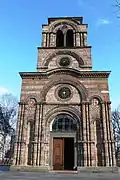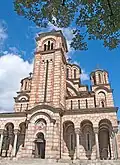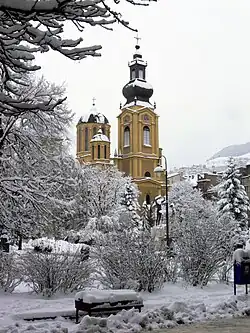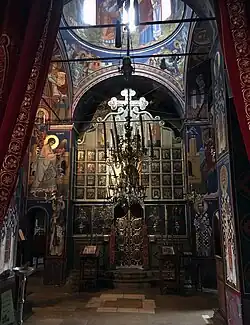Church of St. George, Kneževo
| Church of St. George | |
|---|---|
| Црква светог Ђорђа (Serbian) Crkva svetog Đorđa (Croatian) | |
Church of St. George | |
| 45°50′23″N 18°38′44″E / 45.83972°N 18.64556°E | |
| Location | Kneževo |
| Country | Croatia |
| Denomination | Serbian Orthodox |
| History | |
| Dedication | St. George |
| Architecture | |
| Style | Baroque and Classicism |
| Years built | 1929 |
| Administration | |
| Archdiocese | Eparchy of Osječko polje and Baranja |
The Church of St. George (Serbo-Croatian: Црква светог Ђорђа, Crkva svetog Đorđa) is a Serbian Orthodox church located in Kneževo, eastern Croatia. It was commissioned in 1929 by King Alexander I of Yugoslavia as part of his royal summer residence.[1][2] The church’s interior features two walnut-wood imperial thrones, one for the king and one for the queen.[1] It is the only endowment of the Karađorđević royal family in this part of Croatia.[2]
History
Kneževo was first mentioned in 1214 under the name Lak.[3] In 1905, when the village was part of the Kingdom of Hungary within Austria-Hungary (outside the autonomous Croatia-Slavonia), it had around 600 inhabitants, including 185 Orthodox Christians.[3][4] After the end of World War I, the area became part of the newly established Kingdom of Serbs, Croats and Slovenes (firstly within the Banat, Bačka and Baranja and then the Danube Banovina) ruled by the House of Karađorđević.
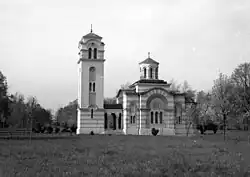
The Church of St. George in Kneževo, village near the town of Beli Manastir, was built in 1929 as a part of the royal summer residence.[2] The church is located within the historical core of Kneževo, which includes several notable buildings and sites such as the Kneževo park, the former Belje administrative building, and the former Belje restaurant.[5] The church was built in the Byzantine Revival style, designed more like a large chapel for the royal residence rather than a Kneževo parish building.[2] After the end of World War II in Yugoslavia, abolition of monarchy in the country and the establishment of the Socialist Republic of Croatia, the church was closed until the mid-1970s when painter Ivan Bens repainted the iconostasis.[2][3] The church building was returned to the Serbian Orthodox Church at that same period.[4]
On 29 November 2019, the parish celebrated the Vow Day of Saint Matthew the Apostle and Evangelist and the 90th anniversary of the church.[6]
See also
- Eparchy of Osječko polje and Baranja
- Oplenac
- Serbs of Croatia
- List of Serbian Orthodox churches in Croatia
References
- ^ a b Sekulić, Srđan (July 2013). Православни храмови источне Славоније, Барање и западног Срема /2/ (PDF). Извор, Joint Council of Municipalities (in Serbian). VII (70). Vukovar. Archived from the original (PDF) on 2013-12-08. Retrieved 2013-08-09.
- ^ a b c d e "Zadužbina kralja Aleksandara Karađorđevića u Kneževu". Srbi.hr, Joint Council of Municipalities. 3 December 2019. Retrieved 8 September 2021.
- ^ a b c "Crkve u Veri, Kneževu, Marincima i Opatovcu". Srbi.hr, Joint Council of Municipalities. 23 April 2018. Retrieved 9 August 2025.
- ^ a b Zoran Popović (22 October 2019). "Slava u Kneževu". Novosti. Retrieved 9 August 2025.
- ^ Ivica Getto (15 January 2025). "Vrijedna povijesna jezgra u Kneževu i dalje propada". Glas Slavonije. Retrieved 9 August 2025.
- ^ Zoran Popović (2 December 2019). "90 godina hrama u Kneževu". Novosti. Retrieved 9 August 2025.
